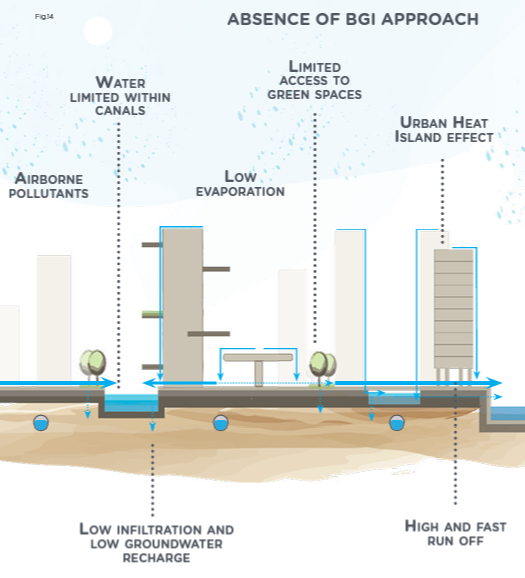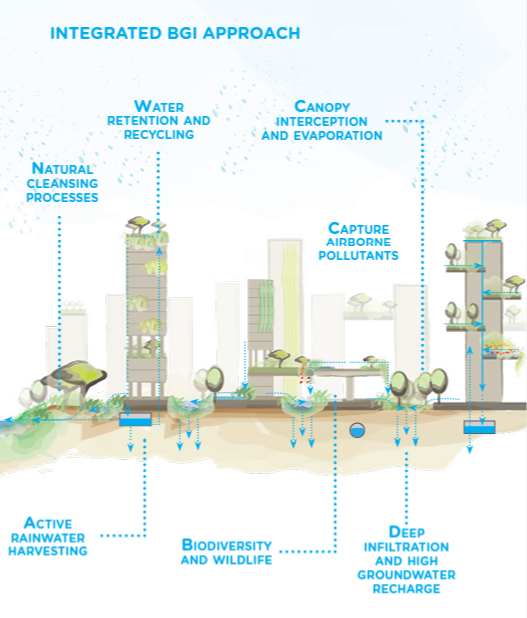Biodiversity & Environment
Blue-Green Infrastructure
This editorial is based on “Why Delhi must invest in blue-green infrastructure” which was published in Hindustan Times on 06/08/2022. It talks about the Blue-Green Infrastructure and its applications.
For Prelims: Blue-Green Infrastructure, Nature-Based Solutions, Smart Cities Mission, Atal Mission for Rejuvenation and Urban Transformation (AMRUT), Sustainable Development Goals (SDGs)
For Mains: Advantages of Blue-Green Infrastructure (BGI), Challenges Associated with the Implementation of Blue-Green Infrastructure, Current Blue-Green Infrastructure Projects Across the Globe
Urbanisation is intrinsic to development and often serves as a major driver of economic growth. India is at the tipping point of transitioning from a rural to an urban society, so it is critical that the economic and social infrastructure are in good shape.
Cities are like living organisms. Our cities occupy just 3% of the nation’s land, but their contribution to the Gross Domestic Product (GDP) is a whopping around 65%.
Cities are also a key contributor to climate change. The inability to effectively streamline, regulate and monitor urbanisation processes is inadvertently responsible for this vast environmental loss.
The need of the hour is incisive, insightful planning and nature-driven solutions as a counter to conventional infrastructure practices in cities by harnessing Blue-Green Infrastructure.
What is Blue-Green Infrastructure?
- Blue-Green Infrastructure refers to a network that provides the “ingredients” for solving urban and climatic challenges by a combination of infrastructure, ecological restoration and urban design to connect people with nature.
- Blue indicates water bodies such as rivers and tanks
- Green indicates trees, parks, and gardens.
What are the Advantages of Blue-Green Infrastructure?
- Environmental benefits: Utilising blue-green infrastructure in sectors such as transportation, water, and housing can improve ecosystem health, thereby improving human health and the environment.
- Incorporating green infrastructure in the city will not only benefit humans but also nature.
- Social benefits: The design and beauty of the landscape can contribute to the identity of the city's character. Green streetscapes and landscapes enhance aesthetic and ethical qualities
- Blue-green infrastructure can provide shelter in public spaces and reduce the urban temperature and increase outdoor activities which encourage more social gatherings.
- Economic benefits: Implementing blue-green projects in the city may also help the citizens economically. Due to low temperature on building surfaces, it diminishes the cooling demand which results in decreasing energy needs.
- The life expectancy of the building increases as green infrastructure will protect it from high temperatures, help in lowering maintenance costs, etc.
What are the Challenges Associated with the Implementation?
- Recognition of Urban Areas: Around 8000 towns are counted as urban for population estimation under the Census of India (2011), however, half of them, known as census towns, are still administratively ‘rural’.
- The lack of ‘urban’ status poses an institutional challenge in terms of planning and management of these settlements that have already attained the urban characteristics.
- Lack of Active Master Plan for Cities: In the present scenario, about 52% of the statutory towns and 76% of the census towns do not have any Master Plans to guide their spatial growth and infrastructural investments.
- It would be difficult to integrate blue-green projects in these cities.
- Lack of Adequate and Technically Qualified Planners in the Public Sector: It is alarming to find that there is not even one planner per urban centre in India.
- According to NITI Aayog indicates that over 12000 posts for town planners are required in the country.
- Disconnect between Urban Planning and Urban Land Records: A city is a ‘system of systems’. City planning cannot be done without good maps with clarity of land titles and ownership.
- Accurate and usable maps of many of the major cities in India do not exist with their functionaries or in the public domain.
What is the Current Blue-Green Infrastructure Projects Across the Globe?
- Active, Beautiful, Clean Waters Programme - Singapore
- Grey to Green Initiative - Portland, Oregon, United States
- Rain City Strategy - Canada
- Sponge City Programme - China
What Should be the Way Forward?
- Towards Nature Based Solutions: Infrastructure planning must become more sensitive to ecological considerations by developing and adapting nature-based solutions to meet climate and sustainability goals, a purpose served by blue-green infrastructure.
- Smart Cities Mission and Atal Mission for Rejuvenation and Urban Transformation (AMRUT) are some good steps in this direction.
- Institutionalising a Blue-Green Urban Framework: An overarching framework should be established to define the national vision and determine guiding principles for such projects.
- For instance, guidelines on tackling uncertainties in terms of designing new water systems can aid quick decision-making at the local level.
- Bottom-Up Approach: Many Indian cities release annual environmental status reports, with details on natural features and pollution indicators.
- Such activities can be integrated with an annual blue-green audit for all cities and be accompanied by demographic data to better understand the social challenges and to develop realistic policy solutions.
- Delhi is one of the first cities in India to include a blue-green infrastructure focus in its 2041 masterplan.
- Such activities can be integrated with an annual blue-green audit for all cities and be accompanied by demographic data to better understand the social challenges and to develop realistic policy solutions.
- Multi Stakeholder- Multilevel Participation: By encouraging community involvement and active interaction with government, planners, policymakers, and other political representatives, blue-green projects will become more understood and the citizens will be more likely to take part in planning, formulation, implementation and monitoring of them.
- In India, initiatives in Bengaluru and Madurai have also included considerable citizen involvement.
- Fast-Tracking Sustainable Development Goals: The COVID-19 pandemic has impacted global and domestic funding capacity for projects related to the UN's Sustainable Development Goals (SDGs).
- Blue-green infrastructure has the potential to fulfil multiple targets outlined in the SDGs, such as those related to water (SDG 6 and SDG 14), land (SDG 15) and climate change (SDG 13).
- It can also accelerate progress on green employment prospects (SDG 1).
- Blue-green infrastructure has the potential to fulfil multiple targets outlined in the SDGs, such as those related to water (SDG 6 and SDG 14), land (SDG 15) and climate change (SDG 13).
- Integrated- BGI Approach:
|
Drishti Mains Question “Harnessing Nature-Based Solutions to meet climate and sustainability goals is a purpose served by Blue-Green Infrastructure.” Explain |
UPSC Civil Services Examination, Previous Year Question (PYQ)
Mains
Q. Explain the purpose of Green Grid Initiative launched at the World Leaders Summit of COP26 UN Climate Change Conference in Glasglow in November 2021. When was the idea first floated in the International Solar Alliance (ISA)? (Answer in 150 words) (2021)






